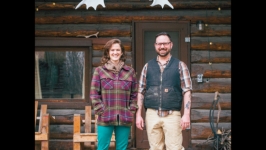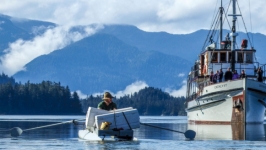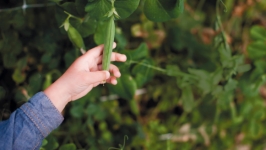How 2 Dutch Immigrants Grew Wheat and a Legacy in Alaska
A half-century ago in 1967, protests against the Vietnam War erupted around the world, the Beatles topped the charts with their new release Sgt. Pepper’s Lonely Hearts Club Band, Elvis and Priscilla tied the knot, and Lyndon B. Johnson served as 36th president of the United States. In the Netherlands that year, a Dutch couple named Ben and Suus VanderWeele stepped onto a plane and flew across the pole to a small town named Palmer, Alaska, holding nothing but two suitcases and each other’s hands.
Ben is a 10th-generation farmer. Suus is a self-proclaimed “city girl.” Today they are the owner-operators of the VanderWeele farm, feeding Alaskans across the state and advocating for the importance of local agriculture. With over 200 acres of land in production, this harvest marks their 50th year of farming in Alaska. If you have ever eaten an Alaska grown potato, chances are it was grown under the midnight sun on the family farm in the Matanuska Valley.
A wall-sized Holland poster hangs inside their barn, a reminder of their cultural heritage. The cheerful VanderWeele Farm logo incorporates Dutch icons tulips and windmills. On a slightly overcast day, Ben heads out to make his rounds. The air is starting to grow crisp at night, like the crunch of a freshly picked carrot, and summer is winding down. On the farm, Ben pulls a potato, his signature crop, from the soil, thoughtfully examining the popular root vegetable that has helped him to become one of the most recognized farmers in the state.
Ben and Suus are both 75, with seemingly endless energy and enthusiasm. The couple’s three adult children, Glen, Michelle and Roger all left the state after high school, eventually returning to work on the farm. Glen manages operations, and when I visit for the first time he is rigging up a control system to automatically open and close the walls of the greenhouse to regulate its temperature. Michelle runs the accounting and business side (“She’s the boss,” Ben says), and Roger uses his soil science background to improve yields. In 2001, the Alaska State Fair awarded them Farm Family of the Year.
Generational family-run farms are becoming increasingly rare throughout the country. We hop in the pick-up truck and drive by a neighboring lot near a VanderWeele potato field. “This family had a dairy farm, but they sold last year because none of their three kids wanted to be farmers,” Ben explains. “So then the developers bought it.
You can’t eat a subdivision
From above, the scene might be recognizable as a page out of a storybook of rural America. The highway in and out of town hums with the bright lights and sounds of traffic, gravel lots and churches dot the roadsides, and red, white and blue flags flutter dreamily in the breeze. In nearby neighborhoods, moose antlers frame front doors, and hanging baskets drip with color. Knick-knacks adorn every yard. And patchworked in between the gravel company mounds, freshly mown grass of the golf course, and multiple subdivisions, lie one hundred acres where the majority of our state’s potatoes are grown.
The VanderWeele’s wish their land was all together, but over the years they have had to buy small parcels as they came on the market, leading to a field here and there. They refer to the different fields by the name of their former owners in homage to them. Ben keeps his handwritten irrigation notes in his front pocket, as a reminder of when he needs to move each system. He laughs, “all these kids and their smart phones; I’m such an old fart.”
“It was in my genes that I wanted to be a farmer”
When Ben and Suus arrived in Alaska in 1967, they planted each seed by hand. Today, with the help of tractors and other specialized machinery, they can transplant, irrigate, and harvest their vegetables on a much larger and faster scale.
One of the first things Ben started to do was observe and track the weather. Every day. He was recently recognized by the National Oceanic and Atmospheric Administration (NOAA) for volunteering as a Cooperative Weather Observer for 45+ years. He is a farmer-scientist, constantly tracking data, and has experimented with hundreds of different seed varieties over the years. One season he tried to grow onions, testing fifty different types, leading Michelle to dub the patch, “Ben’s Bloomin’ Onion Field.” Onions turned out to not be viable financially, due to the fact that they are so cheap in the Lower 48.
We pass a field of wheat, being grown for Fire Island Rustic Bakeshop in Anchorage and waiting to be hand-milled and baked into artisan loaves of bread. When I point out that I’ve never seen any wheat in Alaska, Ben states, “Some said that wheat cannot be grown. So I did it.”
It’s a common theme, but I quickly realize that he is not boasting. Ben and Suus are excited to share what they have learned, and eager to inspire and teach others.
We turn a corner. “This will blow your mind,” said Ben with his trademark grin. We come to a small growth of winter rye, over six feet tall and majestically rustling. VanderWeele is the only farm in the state growing rye, with seeds obtained from the Alaska Plant Materials Center. Ben hopes that it can be made into Alaska grown whiskey one day.
Experimental barley is up next. They need a variety that is recommended for malting, so that local breweries can use it for beer.
The scale of the VanderWeele Farm doesn’t quite make you dizzy until seeing their processing and storage facility. This is a huge piece of the Alaska grown puzzle – and this family is demonstrating that it can be done. From the marketing to the transportation, they do everything “in house.” Vegetables go from the dirt into the washer, and then are sorted by hand on the grading table. Number one potatoes are what consumers might see as “perfect,” and are able to be sold, thus packed and sealed into bags and shipped out. Number twos might have small spots, cracks, or blemishes from the harvest, rendering them commercially unviable. Thousands of pounds of these potatoes and carrots are donated to the local food bank every year.
Although the VanderWeeles’ are able to sell their produce in grocery stores, they continue to rely on a direct sale customer base. Suus goes to the South Anchorage Farmer’s Market on Saturdays to sell their produce. She likes seeing old friends and customers, and the way their veggies make people smile. This year they filled their greenhouse with strawberries – over 7,000 plants – to sell at the market only.
Ben is a founding board member and current chairman of the nonprofit Alaska Farmland Trust, and one of the original people involved with the Alaska Grown program. At the end of the day, it’s obvious to me that the VanderWeele family is special and Alaska lucked out that they chose to make this place home. I wonder out loud if they’ll ever be ready to rest on their laurels and let their children take over.
“Retirement?” Suus laughs. “Then we will do this as a hobby.”
“Farming is in my genes,” replies Ben. His eyes twinkle. “It’s what we love.”
Follow them on Facebook at www.fb.com/VanderWeeleFarm/









